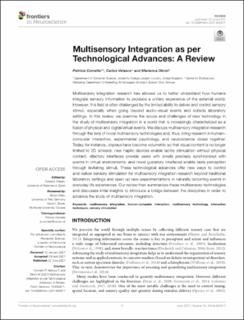Multisensory integration as per technological advances: A review
Journal article, Peer reviewed
Published version
Permanent lenke
https://hdl.handle.net/11250/2979502Utgivelsesdato
2021Metadata
Vis full innførselSamlinger
- Scientific articles [2181]
Sammendrag
Multisensory integration research has allowed us to better understand how humans integrate sensory information to produce a unitary experience of the external world. However, this field is often challenged by the limited ability to deliver and control sensory stimuli, especially when going beyond audio–visual events and outside laboratory settings. In this review, we examine the scope and challenges of new technology in the study of multisensory integration in a world that is increasingly characterized as a fusion of physical and digital/virtual events. We discuss multisensory integration research through the lens of novel multisensory technologies and, thus, bring research in human–computer interaction, experimental psychology, and neuroscience closer together. Today, for instance, displays have become volumetric so that visual content is no longer limited to 2D screens, new haptic devices enable tactile stimulation without physical contact, olfactory interfaces provide users with smells precisely synchronized with events in virtual environments, and novel gustatory interfaces enable taste perception through levitating stimuli. These technological advances offer new ways to control and deliver sensory stimulation for multisensory integration research beyond traditional laboratory settings and open up new experimentations in naturally occurring events in everyday life experiences. Our review then summarizes these multisensory technologies and discusses initial insights to introduce a bridge between the disciplines in order to advance the study of multisensory integration.

